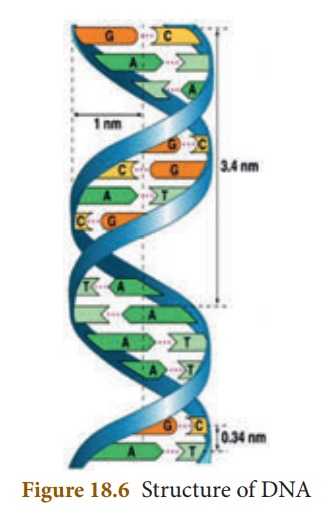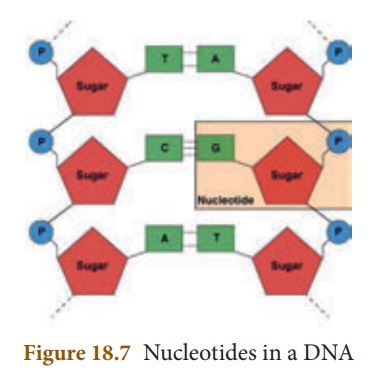Watson and Crick model, Replication, Significance - Structure of DNA | 10th Science : Chapter 18 : Heredity
Chapter: 10th Science : Chapter 18 : Heredity
Structure of DNA
Structure
of DNA
DNA is the hereditary
material as it contains the genetic information. It is the most important
constituent of a chromosome. The most widely accepted model of DNA is the
double helical structure of James Watson and Francis Crick. They
proposed the three-dimensional model of DNA on the basis of X-ray
diffraction studies of DNA obtained by Rosalind Franklin and Maurice Wilkins.
In appreciation of their discoveries on the molecular structure of nucleic
acids Watson, Crick and Wilkins were awarded Nobel prize for Medicine in 1962.
Chemical Composition of DNA molecule
DNA is a large molecule
consisting of millions of nucleotides. Hence, it is also called a polynucleotide.
Each nucleotide consists of three components.
1. A sugar molecules – Deoxyribose sugar.
2. A nitrogenous base.
There are two types of
nitrogenous bases in DNA. They are
(a) Purines (Adenine and Guanine)
(b) Pyrimidines (Cytosine and Thymine)
3. A phosphate group
Nucleoside and Nucleotide
Nucleoside = Nitrogen
base + Sugar
Nucleotide = Nucleoside
+ Phosphate
The nucleotides are
formed according to the purines and pyrimidines present in them.
1. Watson and Crick model of DNA
1. DNA molecule consists of two polynucleotide chains.
2. These chains form a double helix structure with two
strands which run anti-parallel to one another.
3. Nitrogenous bases in the centre are linked to sugar-phosphate
units which form the backbone of the DNA.
4. Pairing between the nitrogenous bases is very specific and is
always between purine and pyrimidine linked by hydrogen bonds.
·
Adenine (A) links Thymine (T) with two hydrogen bonds (A = T)
·
Cytosine (C) links Guanine (G) with three hydrogen bonds( C ≡ G)
This is called complementary
base pairing.

5. Hydrogen bonds between the nitrogenous bases make the DNA
molecule stable.
6. Each turn of the double helix is 34 A° (3.4 nm). There are ten
base pairs in a complete turn.
7. The nucleotides in a helix are joined together by
phosphodiester bonds.

2. DNA Replication
DNA replication is one
of the basic process that occurs within a cell. DNA molecule produces exact
copies of its own structure during replication process. The two strands of a
DNA molecule have complementary base pairs, the nucleotides of each strand
provide the information needed to produce its new strand. The two resulting
daughter cells contain exactly the same genetic information as the parent cell.
DNA replication involves the following steps
Origin of replication
The specific points on
the DNA, where the replication begins, is the site of origin of
replication. The two strands open and separate at this point forming the replication
fork.
Unwinding of DNA molecule
The enzyme called helicase,
bind to the origin of replication site. Helicase separates the two strands of
the DNA. The enzyme called topoisomerase separates the double helix
above the replication fork and removes the twists formed during the
unwinding process. Each of the separated DNA strands function as a template.

Formation of RNA primer
An RNA primer is a short
segment of RNA nucleotides. The primer is synthesized by the DNA template close
to the origin of replication site.![]()
![]()
Synthesis of new complementary strand from the parent strand
After the formation of
RNA primer, nucleotides are added with the help of an enzyme DNA polymerase
and a new complementary strand of DNA is formed from each of the parent strand.
The synthesis is unidirectional.
In one strand, the
daughter strand is synthesized as a continuous strand which is called leading
strand. In the other strand, short segments of DNA are synthesized. This
strand is called lagging strand. The short segments of DNA are called Okazaki
fragments. The fragments are joined together by the enzyme, DNA ligase.
The replication stops
when the replication fork of the two sides meet at a site called terminus,
which is situated opposite to origin of replication site
3. Significance of DNA
· It is responsible for the transmission of hereditary information from one generation to next generation
·
It contains information required for the formation of proteins.
· It controls the developmental process and life activities of an organism.
Related Topics